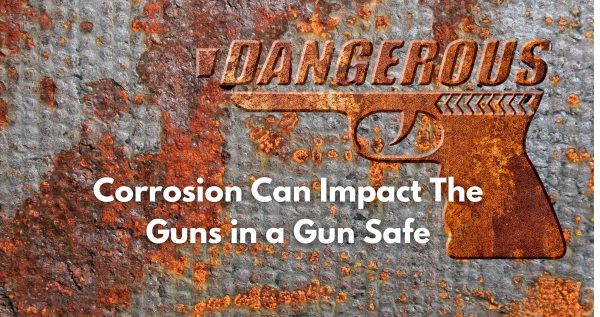Corrosion in a gun safe happens because of the materials used to construct the lining between the metal walls, the carpeting on the floor and shelves, and other chemicals that go into the construction. With that said, all gun safes can corrode if not properly cleaned and stored, just like guns rust and the rust can be removed from the gun.
Some good news, rust cannot spread from one metal to another. But if one metal is rusting or corroding, the cause of the corrosion will likely impact other similar metals, and that is why you want to treat the cause of corrosion the minute it is detected. If the safe is corroding, you can expect your guns to start rusting too.
When guns corrode they become hazards as the barrel can weaken, the bolt and receiver may get damaged, and there is a risk for an explosion if pressure cannot be released properly and propel the cartridge forward.
This is why it is important to check your gun safe for corrosion just like you check your guns for rust. And this starts with knowing what to look for by understanding the main causes of corrosion, and proper care.
The Cause of Gun Safe Corrosion
There are four culprits when it comes to chemical reactions that corrode a gun safe.
- Formaldehyde (CH2O): Used in drywall manufacturing, formaldehyde is a dispersing agent in drywall slurry. These agents vaporize in your safe, creating a potentially caustic environment for metal and wood. Formaldehyde is also present in the adhesive used for carpet interiors and causes significant corrosion, with a corrosion rate over 1.0 mm/year in carbon steel.
- Elemental Sulfur (S): Found in drywall, particularly from China, sulfur reacts with humidity to form hydrogen sulfide and sulfuric acid. The acid attacks metals differently, but in the end it is about corrosion.
Carbon steel for example has some protection as it forms hydrogen gas and ferrous ions forming a protective layer on the safe, while stainless steel’s protection is dependent on the temperature and concentration level of the acid.
- Pyrite (Iron Sulfide): Common in gypsum, pyrite reacts with oxygen and water to form iron oxide-hydroxide (rust) and sulfuric acids. Pyrite in drywall can lead to rapid gun rust.

- Ferrooxidans Bacteria: This metal-eating bacteria lives on the pyrite in drywall, breaking it down into iron hydroxide and sulfur-based acids. The bacteria can also consume other metals, exacerbating corrosion.
As you can see this is a metal gun safe issue, it is literally from the inside out. It is also why you don’t always see concerns about gun safe corrosion in wood and glass display cabinets, or the old shotgun above the fireplace. Although moisture in general can lead to rusting, these storage and display types have different types of corrosion problems.
How to Detect Gun Safe Corrosion
Spotting corrosion in your gun safe is easy when you know what to look for including:
- A sulfur (earthy) smell once you open the door or get close
- Rust inside or on the outside
- Discoloration of the materials and metal
Why Gun Safes Use Materials That Cause Corrosion
If you’re wondering why a gun safe manufacturer would use these materials knowing they can cause corrosion, the answer is simple. It’s cheaper and lighter.
Traditional safes are based on the original Silas Herring design and used thick outer steel, thin inner steel, and plaster or cement in the middle. This design was abandoned in the 1980s in favor of cheaper, lighter materials. The result is the modern gun safe: a thin-walled steel box lined with drywall and carpeted over.
When these changes occurred UL (Underwriters Laboratories) created a new classification. Class RSC–Residential Security Container. The RSC is the standard gun safe sold in most stores throughout America.
If you have purchased a gun safe made after 1980 it is most likely a UL Class RSC. It is drywall based and subject to all the corrosion issues above. Your best defense against corrosion is still well-cleaned and well-lubricated firearms combined with proper gun safe care.
Pro-tip: Open the door regularly and let your safe air out. This will reduce the corrosive sulfur compound buildup. Dehumidifiers slow the process by lowering humidity, but they don’t stop it.
How to Prevent Corrosion in a Gun Safe
The first thing to do is avoid buying gun safes with drywall or carpeting. Instead, consider safes that follow the Herring double-walled steel design, offering better security and modest fire protection. However, these safes are expensive, starting at around $6,000.
Alternatively, steel cabinets can be a viable option. They provide similar security and fire protection as drywall-based gun safes but without as many of the corrosion issues. Smaller, modular steel cabinets offer flexibility and can be easily secured throughout a home, providing quick access in emergencies.
You may also want to try a vented gun safe. This style is designed with ventilation systems that allow for better air circulation, significantly reducing humidity levels inside the safe.
By lowering humidity, the risk of moisture-induced corrosion is minimized. Additionally, vented gun safes help in dissipating harmful gasses and vapors that can emanate from materials like drywall and carpet adhesives. The controlled environment ensures that the internal atmosphere remains less corrosive, thereby extending the lifespan of your firearms.
Corrosion is an issue that impacts gun safes, and when they are impacted the guns inside are likely at risk too. This is why you want to check your safe regularly for any signs of corrosion and invest in a properly built safe using the Silas Herring design if corrosion is a concern. And you can shop our selection of gun safes built to keep your “guns safe”.
